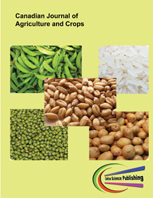Preliminary Evaluation of Different Seed Dormancy Breaking Methods in Wild Tuber Cowpea (Vigna Vexillata)
DOI:
https://doi.org/10.20448/803.4.1.33.40Keywords:
Dormancy, Germination, Scarification, Mechanical, Storage, Viability, Wild seeds.Abstract
Effectiveness of different seed dormancy breaking methods in Vigna vexillata seeds were evaluated. Two germination tests were done at 1 and 4 weeks after seed collection. A randomized completely block design (RCBD) with 8 seed dormancy breaking methods was used. The methods were; pre-chilling (PRC) in 5oC for 1 week, preheating (PRH) at 35oC for 1 week, sealed polythene envelops (SPE), gibberellic acid (GA3) 0.05%, potassium nitrate (KNO3) 0.2%, sulfuric acid scarification (H2SO4) and mechanical scarification (MS) and a control. The H2SO4 and MS had highest germination percentage. There was a significant difference in germination between seeds sown at 1 and 4 weeks after seed harvesting. Sowing V. vexillata seeds at 4 weeks after harvesting had higher germination percentage than 1 week after harvesting. Therefore H2SO4 and MS were effective in breaking seed dormancy at least 4 weeks after harvesting. It is important to repeat the experiment and perform viability tests prior to sowing as this study assumed that all seeds were viable.


